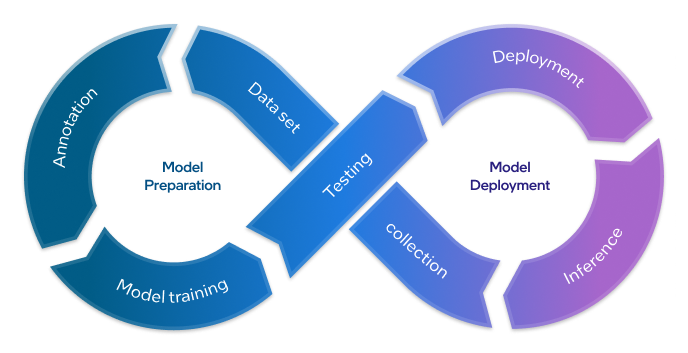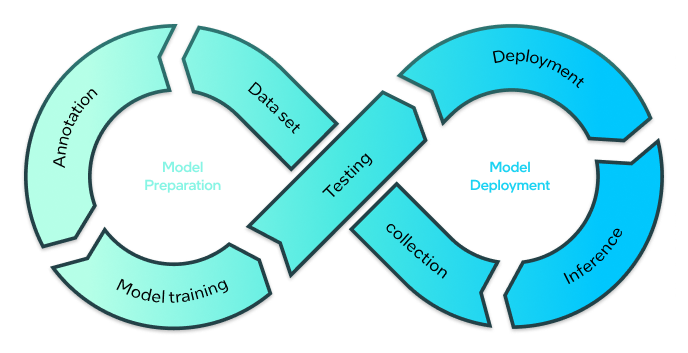

Build AI From End-To-End
From data collection up to model deployment: Intel® Geti™ makes it easy for any user to go from data to model in minimum amount of time.
Models Optimized For Intel Hardware
Train and deploy your computer vision model with optimized performance for Intel hardware. Deploy your model in the precision that meets your needs.
Free & Open Access
Use Intel® Geti™ the way you want: deploy the software for free on your own hardware with our installer, or access the source code on GitHub.
Start Building AI with Intel® Geti™
Flexible deployment options to get you started.
Installer
Install using Helm
Get started with Intel® Geti™ by using our install script. This is our recommended approach when installing on a fresh Ubuntu server.
curl -sL https://docs.geti.intel.com/install-geti.sh -o install-geti.sh && sudo chmod +x install-geti.sh && sudo ./install-geti.sh
Or download the installer manually and follow the steps in our "Learn more" section.
Learn more

Intel® Geti™ Model Lifecycle
Intel® Geti™ enables anyone to build computer vision AI models in a fraction of the time and with minimal data.
The software provides you with a seamless, end-to-end workflow to prepare state-of-the-art
computer vision models in minutes.


Data Collection
Building world-class computer vision models starts with collecting the right data to train a model with. Directly upload your image and video data, or capture data in real time using a connected camera source.
Do you have a labeled dataset ready to use? Intel® Geti™ facilitates dataset import and export in Datumaro format, YOLO, COCO, or Pascal VOC.
Learn more


Data Labeling
The quality of your dataset determines the performance of your trained model in real-life deployment setups. Explore how Intel® Geti™ helps you label your image and video data in the minimum amount of time.
- Active learning
- Visual prompting
- Annotation assistants
Benefit from Intel Geti's Active Learning workflow, where human experts become teachers who stay in the loop during the model development process. Active Learning makes data labeling and model training faster and less labor intensive by automatically selecting the images based on their informative features compared to the rest of your dataset.
With the interactive model training flow, you can get started with as little as 20-30 images or videos to build your first model iteration. By correcting the model’s predictions, you teach the model as it incrementally learns from your data.
Learn more


Accelerate data labeling with the Intel Geti Visual Prompting workflow, utilizing the Segment Anything Model from Meta Al.
Visual Prompting enables you to prompt a working model with just a single annotation. As a result, the Visual Prompting model will return predictions as soon as at least one image in the training dataset has been annotated, which will drastically decrease the effort it takes you to label your dataset.
Learn more


For each use case, Intel® Geti™ provides you with the right tools to label your dataset as fast as possible. Whether your data consists of many small particles that need to be detected, or you need to accurately segment an object so that you can measure its exact dimensions: Intel® Geti™ has you covered with a variety of smart annotation assistants in addition to our (rotated) bounding box-, circle-, and polygon tools.
Examples include the Detection Assistant, which highlights objects similar to the one you annotated, and Automatic Segmentation, which automatically segments the object of interest when you hover over it.
Learn more


Model Training
Intel® Geti™ utilizes state-of-the-art neural network models for key computer vision tasks. For each task, Intel® Geti™ recommends various model variants (Accuracy, Speed, and Balance) to help you select the right model for your use case. With all the Intel® Geti™ models having Apache 2.0 license, you can download and deploy all your trained models for free.
- Detection
- Segmentation
- Classification
- Anomaly
- Chained tasks
Object detection - "the what and where" - can be used when you need to locate and classify specific objects within an image or video frame. Example use cases can be to detect objects through surveillance cameras, spot weeds for agriculture use cases, or quality control on assembly lines in manufacturing.
Learn more


Segmentation - "the what, where, shape" - is used when you need to precisely delineate the shape and boundaries of objects within an image or video frame. Example use cases include medical imaging to identify tumours or organs, autonomous vehicles for road scene understanding, factory production lines to measure the shape and size of items, and image editing applications for background removal or object isolation.
Learn more


Classification - "the what" - is used when you need to assign an image or video frame to a specific category without identifying object locations. Example use cases include identifying different bird species in wildlife photography, detecting defective products in manufacturing quality control, and classifying food items in self-checkout systems.
Learn more


Anomaly detection - "the unusual" - is used when you need to identify patterns or events that deviate from the usual. Example use cases include identifying defects in manufacturing processes, monitoring equipment for predictive maintenance, and detecting unhealthy crops or pests in agricultural fields.
Learn more


Task chains - "the sequence" - can be useful when you need to perform a series of interconnected computer vision tasks in a specific order. Example use cases include detecting and classifying animal species on wildlife camera feeds, or detecting cars and segmenting their license plates for traffic management.
Learn more


Model Testing
To make sure that your trained model is fit-for-purpose, you can evaluate the model’s performance on unseen data with Intel® Geti™’s built-in testing options. Intel® Geti™ allows you to quickly test your model on a single image or run a test on a designated testing set.
Learn more


Model Optimization & Deployment
Under the hood, Intel® Geti™ utilizes the OpenVINO™ toolkit to optimize the model performance for deployment across the whole Intel hardware portfolio in different quantizations so that you can choose the precision that fits your use case: INT8, FP16, and FP32.


Once your model is ready for integration, Intel® Geti™ offers a range of deployment options to put your model to work in real-time. Whether you want to easily run inference in our dedicated Test Drive GUI, run your application as an inference server, or utilize the Intel® Geti™ SDK: with Intel Geti™, you can easily put your model to action with the deployment option that meets your needs.

